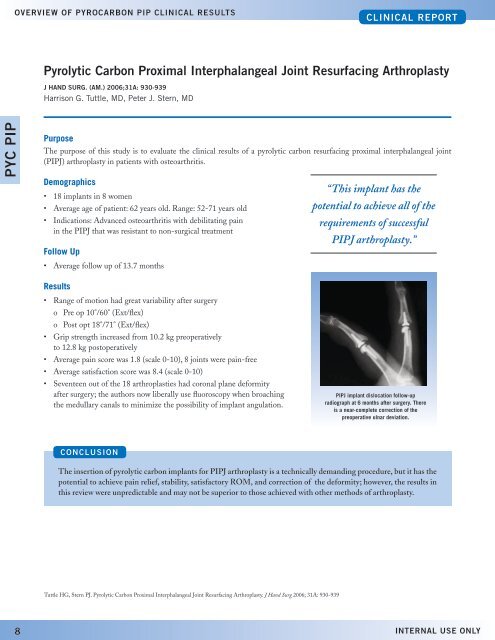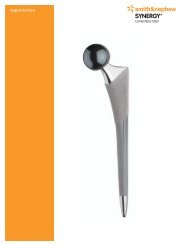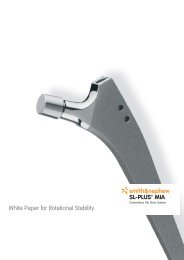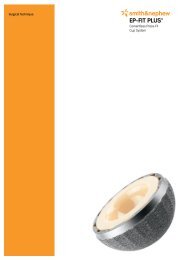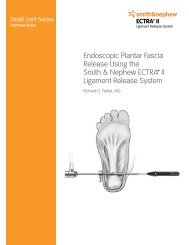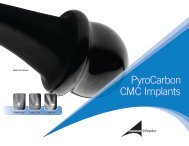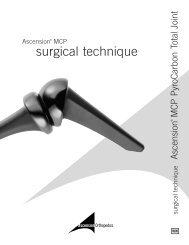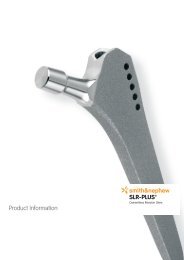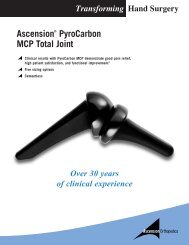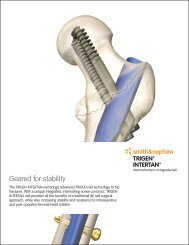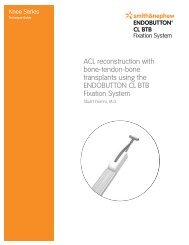Proximal interphalangeal Joint arthroplasty
Proximal interphalangeal Joint arthroplasty
Proximal interphalangeal Joint arthroplasty
Create successful ePaper yourself
Turn your PDF publications into a flip-book with our unique Google optimized e-Paper software.
Overview of PyroCarbon PIP Clinical Results<br />
CLINICAL report<br />
Pyrolytic Carbon <strong>Proximal</strong> Interphalangeal <strong>Joint</strong> Resurfacing Arthroplasty<br />
J Hand Surg. (am.) 2006;31A: 930-939<br />
Harrison G. Tuttle, MD, Peter J. Stern, MD<br />
PYC PIP<br />
Purpose<br />
The purpose of this study is to evaluate the clinical results of a pyrolytic carbon resurfacing proximal <strong>interphalangeal</strong> joint<br />
(PIPJ) <strong>arthroplasty</strong> in patients with osteoarthritis.<br />
Demographics<br />
• 18 implants in 8 women<br />
• Average age of patient: 62 years old. Range: 52-71 years old<br />
• Indications: Advanced osteoarthritis with debilitating pain<br />
in the PIPJ that was resistant to non-surgical treatment<br />
Follow Up<br />
• Average follow up of 13.7 months<br />
“This implant has the<br />
potential to achieve all of the<br />
requirements of successful<br />
PIPJ <strong>arthroplasty</strong>.”<br />
Results<br />
• Range of motion had great variability after surgery<br />
o Pre op 10°/60° (Ext/flex)<br />
o Post opt 18°/71° (Ext/flex)<br />
• Grip strength increased from 10.2 kg preoperatively<br />
to 12.8 kg postoperatively<br />
• Average pain score was 1.8 (scale 0-10), 8 joints were pain-free<br />
• Average satisfaction score was 8.4 (scale 0-10)<br />
• Seventeen out of the 18 arthroplasties had coronal plane deformity<br />
after surgery; the authors now liberally use fluoroscopy when broaching<br />
the medullary canals to minimize the possibility of implant angulation.<br />
PIPJ implant dislocation follow-up<br />
radiograph at 6 months after surgery. There<br />
is a near-complete correction of the<br />
preoperative ulnar deviation.<br />
CONCLUSION<br />
The insertion of pyrolytic carbon implants for PIPJ <strong>arthroplasty</strong> is a technically demanding procedure, but it has the<br />
potential to achieve pain relief, stability, satisfactory ROM, and correction of the deformity; however, the results in<br />
this review were unpredictable and may not be superior to those achieved with other methods of <strong>arthroplasty</strong>.<br />
Tuttle HG, Stern PJ. Pyrolytic Carbon <strong>Proximal</strong> Interphalangeal <strong>Joint</strong> Resurfacing Arthroplasty. J Hand Surg 2006; 31A: 930-939<br />
8<br />
INTERNAL USE ONLY


